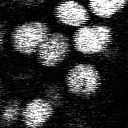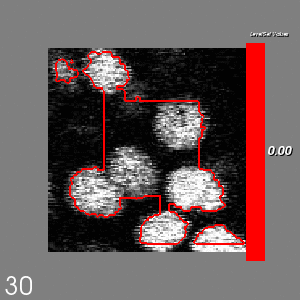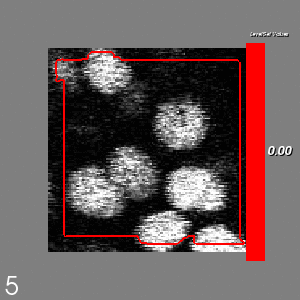Visualize an Evolving Dense 2D Level-Set Zero-Set#
Synopsis#
Visualize the evolving zero-set of a dense level-set function 2D rendered.
Results#

Input image#

Evolving level-sets#

Code#
C++#
#include "itkBinaryImageToLevelSetImageAdaptor.h"
#include "itkImageFileReader.h"
#include "itkLevelSetIterationUpdateCommand.h"
#include "itkLevelSetContainer.h"
#include "itkLevelSetEquationChanAndVeseInternalTerm.h"
#include "itkLevelSetEquationChanAndVeseExternalTerm.h"
#include "itkLevelSetEquationContainer.h"
#include "itkLevelSetEquationTermContainer.h"
#include "itkLevelSetEvolution.h"
#include "itkLevelSetEvolutionNumberOfIterationsStoppingCriterion.h"
#include "itkLevelSetDenseImage.h"
#include "itkVTKVisualizeImageLevelSetIsoValues.h"
#include "itkSinRegularizedHeavisideStepFunction.h"
int
main(int argc, char * argv[])
{
if (argc != 3)
{
std::cerr << "Missing Arguments" << std::endl;
std::cerr << argv[0] << std::endl;
std::cerr << "1- Input Image" << std::endl;
std::cerr << "2- Number of Iterations" << std::endl;
return EXIT_FAILURE;
}
// Image Dimension
constexpr unsigned int Dimension = 2;
using InputPixelType = unsigned char;
using InputImageType = itk::Image<InputPixelType, Dimension>;
InputImageType::Pointer input = itk::ReadImage<InputImageType>(argv[1]);
int numberOfIterations = std::stoi(argv[2]);
using LevelSetPixelType = float;
using LevelSetImageType = itk::Image<LevelSetPixelType, Dimension>;
using LevelSetType = itk::LevelSetDenseImage<LevelSetImageType>;
using LevelSetOutputType = LevelSetType::OutputType;
using LevelSetRealType = LevelSetType::OutputRealType;
// Generate a binary mask that will be used as initialization for the level
// set evolution.
using BinaryImageType = itk::Image<LevelSetOutputType, Dimension>;
auto binary = BinaryImageType::New();
binary->SetRegions(input->GetLargestPossibleRegion());
binary->CopyInformation(input);
binary->Allocate();
binary->FillBuffer(itk::NumericTraits<LevelSetOutputType>::Zero);
BinaryImageType::RegionType region;
BinaryImageType::IndexType index;
BinaryImageType::SizeType size;
index.Fill(5);
size.Fill(120);
region.SetIndex(index);
region.SetSize(size);
using InputIteratorType = itk::ImageRegionIteratorWithIndex<BinaryImageType>;
InputIteratorType iIt(binary, region);
iIt.GoToBegin();
while (!iIt.IsAtEnd())
{
iIt.Set(itk::NumericTraits<LevelSetOutputType>::One);
++iIt;
}
// convert a binary mask to a level-set function
using BinaryImageToLevelSetType = itk::BinaryImageToLevelSetImageAdaptor<BinaryImageType, LevelSetType>;
auto adaptor = BinaryImageToLevelSetType::New();
adaptor->SetInputImage(binary);
adaptor->Initialize();
LevelSetType::Pointer levelSet = adaptor->GetModifiableLevelSet();
// The Heaviside function
using HeavisideFunctionType = itk::SinRegularizedHeavisideStepFunction<LevelSetRealType, LevelSetRealType>;
auto heaviside = HeavisideFunctionType::New();
heaviside->SetEpsilon(1.5);
// Create the level set container
using LevelSetContainerType = itk::LevelSetContainer<itk::IdentifierType, LevelSetType>;
auto levelSetContainer = LevelSetContainerType::New();
levelSetContainer->SetHeaviside(heaviside);
levelSetContainer->AddLevelSet(0, levelSet);
// Create the terms.
//
// // Chan and Vese internal term
using ChanAndVeseInternalTermType =
itk::LevelSetEquationChanAndVeseInternalTerm<InputImageType, LevelSetContainerType>;
auto cvInternalTerm = ChanAndVeseInternalTermType::New();
cvInternalTerm->SetInput(input);
cvInternalTerm->SetCoefficient(0.5);
// // Chan and Vese external term
using ChanAndVeseExternalTermType =
itk::LevelSetEquationChanAndVeseExternalTerm<InputImageType, LevelSetContainerType>;
auto cvExternalTerm = ChanAndVeseExternalTermType::New();
cvExternalTerm->SetInput(input);
// Create term container (equation rhs)
using TermContainerType = itk::LevelSetEquationTermContainer<InputImageType, LevelSetContainerType>;
auto termContainer = TermContainerType::New();
termContainer->SetLevelSetContainer(levelSetContainer);
termContainer->SetInput(input);
termContainer->AddTerm(0, cvInternalTerm);
termContainer->AddTerm(1, cvExternalTerm);
// Create equation container
using EquationContainerType = itk::LevelSetEquationContainer<TermContainerType>;
auto equationContainer = EquationContainerType::New();
equationContainer->SetLevelSetContainer(levelSetContainer);
equationContainer->AddEquation(0, termContainer);
// Create stopping criteria
using StoppingCriterionType = itk::LevelSetEvolutionNumberOfIterationsStoppingCriterion<LevelSetContainerType>;
auto criterion = StoppingCriterionType::New();
criterion->SetNumberOfIterations(numberOfIterations);
// Create the visualizer
using VisualizationType = itk::VTKVisualizeImageLevelSetIsoValues<InputImageType, LevelSetType>;
auto visualizer = VisualizationType::New();
visualizer->SetInputImage(input);
visualizer->SetLevelSet(levelSet);
visualizer->SetScreenCapture(true);
// Create evolution class
using LevelSetEvolutionType = itk::LevelSetEvolution<EquationContainerType, LevelSetType>;
auto evolution = LevelSetEvolutionType::New();
evolution->SetEquationContainer(equationContainer);
evolution->SetStoppingCriterion(criterion);
evolution->SetLevelSetContainer(levelSetContainer);
using IterationUpdateCommandType = itk::LevelSetIterationUpdateCommand<LevelSetEvolutionType, VisualizationType>;
auto iterationUpdateCommand = IterationUpdateCommandType::New();
iterationUpdateCommand->SetFilterToUpdate(visualizer);
iterationUpdateCommand->SetUpdatePeriod(5);
evolution->AddObserver(itk::IterationEvent(), iterationUpdateCommand);
evolution->Update();
return EXIT_SUCCESS;
}
